Source: University of Nebraska Extension
Five no-tillers worked with the Nebraska On-Farm Research Network in 2014 to assess the use of cover crops for their farming operations. Specifically, these growers were concerned with the impact of cover crops on the yield of the subsequent cash crop. The cover crop mixtures and cash crops varied by location. The results of these five studies are explored here, moving from west to east across the state.
Phelps County
The first study was in Phelps County, approximately 4.5 miles southwest of Loomis, on a Holdrege silt loam soil. The objective was to determine the impact of a cover crop on the yield of the subsequent wheat crop.
To determine this, a cover crop mix was seeded at 25 pounds per acre into corn stubble in spring 2013. The mixture contained ‘Reeves' oats (52%), spring triticale (21%), common vetch (13%), Ed annual ryegrass (6%), flax (6%), and De rapeseed (2%). The cover crop was terminated in August 2013 using 80 ounces per acre Glystar Plus and 8.25 ounces per acre Clarifier. Settler winter wheat was drilled into the previous crop residue and cover crop residue in September 2013 at a population of 987,780 seeds per acre.
The yield of wheat planted into cover crop residue was compared to wheat planted into corn stubble with no cover crop (check). Four replications were planted and harvested. Rainfall for 2014 was below the 10-year average during the summer months for this non-irrigated site. Normal precipitation for July and August is around 6.5 inches; however, this year there was only 1.8 inches of rainfall during this period.
The cover crop treatment resulted in wheat yields that were 20 bushels per acre less than the check yields and higher in grain moisture (Table 1). Overall, the cover crop treatment resulted in a loss of $154.08 per acre.
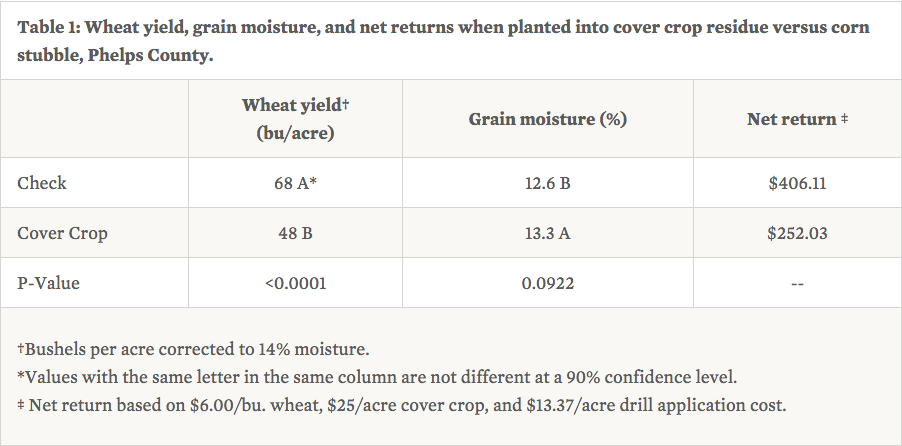
|
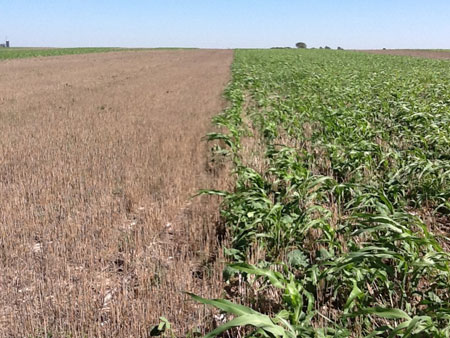
|
| Figure 1. |
This study was located approximately 2 miles south of Wilcox on a Holdrege silt loam soil. The cover crop was a mix of sorghum x sudangrass (4%), forage rapeseed (4%), Tilth Pro NitroRadish or Jackhammer Radish (4%), forage pea (59.1%) and hairy vetch (18.2%). It was drilled at 22 pounds per acre into wheat stubble in August 2013; the cover crop did not survive the winter (Figure 1). Corn was planted into the cover crop residue on May 4, 2014 at a rate of 23,000 seeds per acre. Planting corn into the cover crop was compared to planting corn into wheat stubble without a cover crop (check). Soil moisture data was collected in fall 2013, spring 2014 and fall 2014. This site was not irrigated; rainfall was above the 10-year average throughout 2014, with the exception of April when rainfall was slightly below the 10-year average.
Franklin County
Twelve replications of the two treatments were planted and harvested to determine corn grain yield. The corn planted into the wheat stubble without a cover crop was higher yielding and higher in grain moisture than the corn following cover crop (Table 2). There was no difference in soil moisture between the check and cover crop in fall 2013 or 2014; however, in spring 2014 the soil in the area without cover crops had higher moisture than soil in the cover crop treatment.
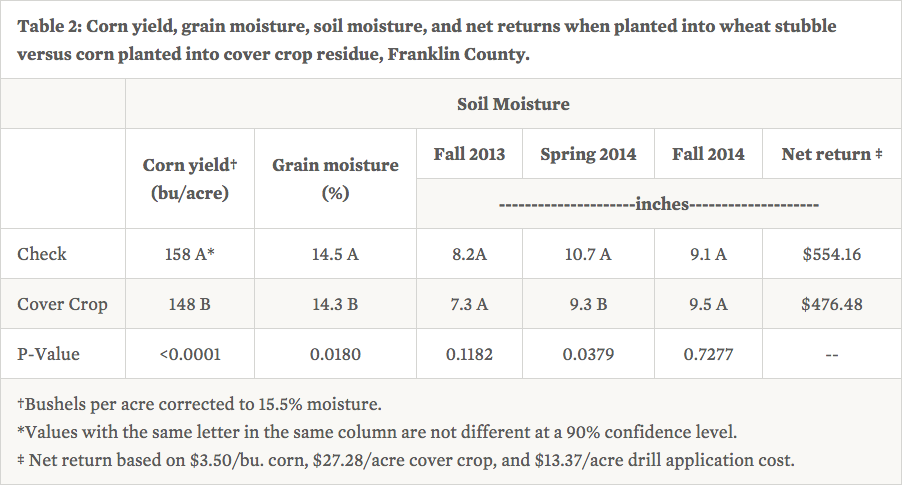
|
Clay County
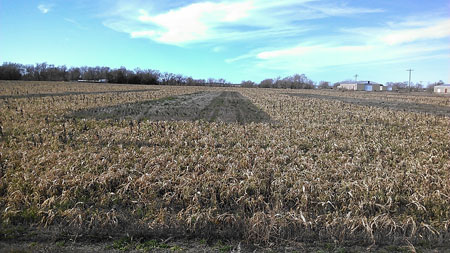
|
| Figure 2. |
This study was in Clay County, approximately 0.5 miles northeast of Glenvil on a Hastings silt loam soil. The objective of this study was to determine the effects of a summer cover crop mix following wheat on the yield of the subsequent corn crop. The cover crop mix included winter pea, mung bean, sorghum x sudangrass, pearl millet, oats, NitroRadish and sunflower. The mixture was seeded at 36 pounds per acre into wheat stubble on Aug. 3, 2013; it did not survive the winter. Treatment strips are shown in Figure 2. Corn was planted into the wheat stubble and cover crop residue on May 6, 2014 at a planting population of 27,500 seeds per acre. This site was not irrigated and rainfall in 2014 was close to the 10-year average from January to March, below average for April and May, and above average from July through the remainder of the growing season. Six replications of the two treatments were planted and harvested.
The yield of corn planted into cover crop residue was compared to the yield of corn planted into wheat stubble with no cover crop (check). The cover crop mixture resulted in lower yields for the following corn crop (Table 3). There was no difference in grain moisture or test weight for either treatment. Harvest stand counts were greater for the cover crop than for the no-cover crop treatment. The yield reduction and cost of cover crop resulted in an economic loss of $50.50 per acre.
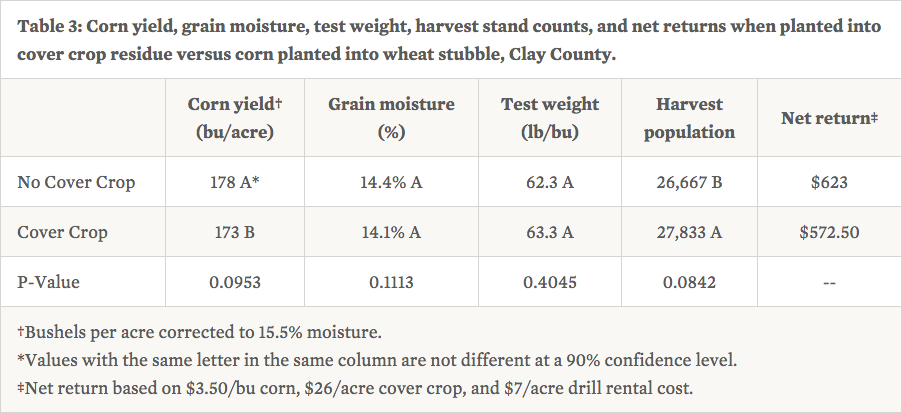
|
Seward County
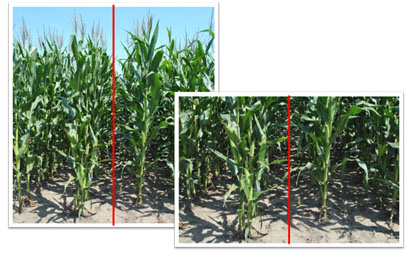
|
| Figure 3. |
This study was in Seward County, 1 mile west of Beaver Crossing. Soil types at this site included Hastings silty clay loam, Crete silt loam, Muir silt loam, Butler silt loam and Coly-Hobbs silt loam. The objective of the study was to determine the effect of a cereal rye cover crop on the subsequent corn grain yield. Cereal rye was seeded at 40 pounds per acre into soybean stubble on Oct. 10, 2013. Corn was planted into the soybean stubble and cereal rye residue on April 22, 2014 at a planting population of 34,000 seeds per acre. Corn was planted into the cover crop residue and into the soybean stubble with no cover crop (check) (Figure 3). Rainfall for the year was at the 10-year average for January through March, below average for April through June, and close to or slightly above average for the remainder of the growing season. This site was center-pivot irrigated. Six replications of the two treatments were planted and harvested (Table 4).
There was no grain yield difference between the corn planted into the cereal rye residue and corn planted into soybean stubble. However, calculated net return was approximately $26 per acre less for the cereal rye cover crop.
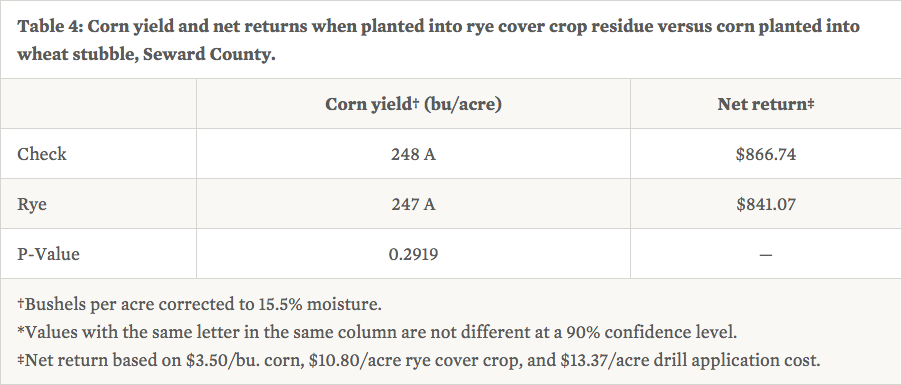
|
Saunders County
This study was in Saunders County, approximately 4 miles east of Ithaca. Soil types at this location include Yutan silty clay loam and Filbert and Tomek silt loam. The objective of the study was to determine the effects of grazed and non-grazed cover crops following wheat on subsequent soybean yield. This study was different in that it included three treatments: soybeans planted into wheat (check), soybeans planted after a cover crop, and soybeans planted after a grazed cover crop.
The cover crop used in this study was a mix of clover (1 pound per acre), Sordan 79 (1 pound per acre), oats (15 pounds per acre), purple top turnips (2 pounds per acre), and sunflower (2 pounds per acre). It was seeded at 21 pounds per acre into wheat stubble on Aug. 19, 2013 and was winter killed. For the grazed treatment, one steer per acre began grazing on Nov. 12, 2013 and completed grazing on Dec. 30, 2013 for a total of 48 days of grazing. Overall, ADG was 2.03 pounds with a total gain of 97 pounds per acre. Forage production was 1.08 tons per acre (dry matter).
Soybeans were planted into all three treatments on April 26, 2014 at a planting rate of 140,000 seeds per acre. Soybeans were replanted on May 21, 2014 due to 50% stand reduction across the field. (Prior to replant the remaining first stand of soybeans was killed with Aim.) This site was center-pivot irrigated and received 6.25 inches of irrigation water over the growing season. Rainfall was at the 5-year average from January through April, slightly below average in May, and above average for the remainder of the growing season. Three replications of the three treatments were planted and harvested. There was no difference in yield of the soybeans planted into wheat stubble (check), planted into cover crop, or planted into grazed cover crop (Table 5).
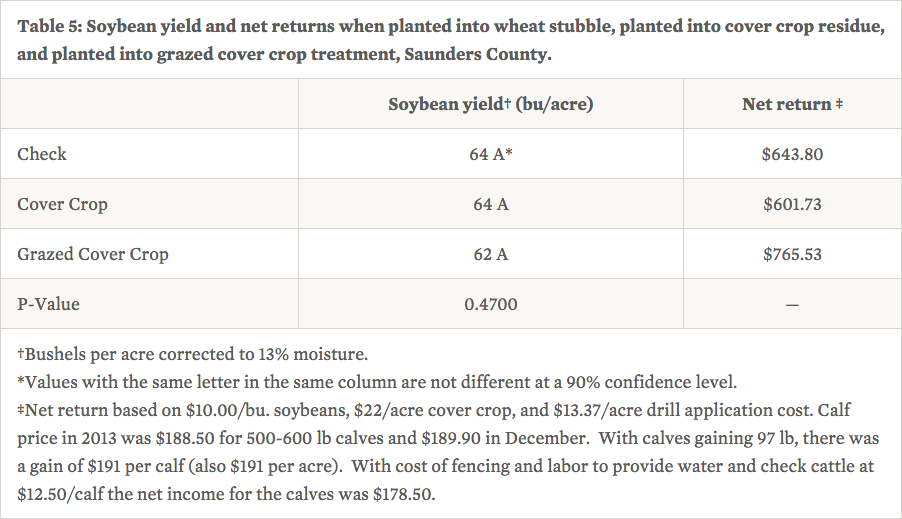
|
Conclusion
The impact of cover crops on subsequent grain crop production is not well documented and more research is needed. Most of these sites were planted to cover crops for the first time and all five of these sites were conducted in no-till fields. In these five studies, grain yield decreased following cover crops in three of the studies, while grain yield was not different between cover crop and check treatments for two studies. This illustrates the critical need for additional research in this area. Despite yield losses in some cases, the farmers are interested in repeating the studies in the future. Further cover crop studies with the Nebraska On-Farm Research Network are planned for the 2015 growing season. Of particular interest is an integrated approach making use of cover crops as a source of livestock forage in a diversified crop rotation.
If you have interest in participating in cover crop research on your farm with the Nebraska On-Farm Research Network please contact Keith Glewen (kglewen1@unl.edu or 402-624-8005), Laura Thompson (laura.thompson@unl.edu or 402-624-8033), or your local Extension Educator.






Post a comment
Report Abusive Comment